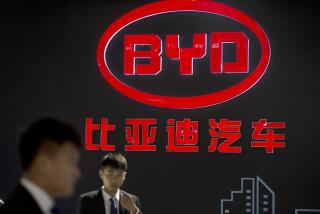A Big Shift Gives U.S. Car Makers the Lead
- Share via
Throughout this long bull market, as average stock prices of big companies have soared to more than 20 times their earnings per share, one of the biggest world industries has been missing from the action.
Automobile company stocks, particularly those of U.S. firms General Motors, Ford and Chrysler, have bumped along at less than 10 times earnings per share, a discount of more than 50% from the market as a whole. The lag was understandable. The car business is not as profitable as the high-tech industries; cars are in oversupply worldwide, and price cutting is rampant.
But perspectives are changing. The dramatic merger announcement this month of Chrysler and Germany’s Daimler-Benz has raised the sights of professional investors and analysts. They now see the automotive industry as a truly global long-term business that is beginning to separate the weak from the strong.
And this new thinking has led several analysts and money managers to find more value in General Motors than is reflected in the current stock price of about $72 a share. Mainly, the pros are impressed by the value of GM’s Hughes Electronics subsidiary--a fast-growing satellite communications company--and its Delphi auto parts division.
*
Those valued divisions, plus the vast operations that make GM the world’s largest producer of cars and trucks, at almost 8 million vehicles a year, make the company’s stock look cheap at its current price, suggested money manager Kevin Risen, who heads two mutual funds for the Neuberger & Berman investment firm.
But there is another big reason Wall Street is taking another look at the U.S. auto firms: the Asian crisis.
Simply put, the Asian crisis is changing the world automobile picture because it is neutralizing major competitive companies. Nissan and Mitsubishi Motors in Japan and all of the fledgling South Korean car companies face a difficult future. Because of changing economic conditions in Japan and currency devaluations in South Korea, many car makers there lack the capital to continue robust product development and to mount effective worldwide marketing.
Yes, the conventional expectation is that the Korean car makers--Hyundai, Daewoo, Samsung and Kia--will flood world markets with cars in an attempt to earn foreign currency. But doing that will not be easy in a new environment in which capital is scarce.
And beyond the current period, even big companies such as Nissan, which has been hurt by falling sales and near-zero profit, won’t have access to low-cost capital as Japan’s financial system undergoes wrenching reforms. That means less money is available to develop new models and keep up with the demands of global competition.
“But General Motors and Ford have capital and strong balance sheets and the ability to move forward in the global market,” says leading automotive analyst Maryann Keller of the Furman Selz investment firm.
“In my 26 years as an analyst, this is the first time I could say that the U.S. automobile makers have the best prospects to lead the world industry in the next decade,” says Keller.
For the last three decades, Japanese companies have led the global industry. But the lead of companies such as Toyota and Honda in vehicle quality or in economy of production has been narrowing in recent years.
Now, with Japan itself going through profound economic changes, Toyota and Honda will have their hands full.
“Therefore, GM and Ford deserve a higher multiple,” says Keller, using the Wall Street term for price-to-earnings ratio.
Chrysler, which has achieved the greatest efficiency of any U.S. auto maker, has already fulfilled its potential by combining with Daimler to become a world-leading company, Keller says.
Those are strong words. And to be sure, exciting times lie ahead. But qualifications are necessary. This is still a business that sells many cars at hefty discounts. In this year’s first quarter, GM had to give a total of $1.5 billion in rebates to move cars and trucks. That more than canceled out the $1.2 billion in cost savings the company achieved in first-quarter production and marketing.
Car buffs continue to criticize General Motors for dull styling in its automobiles; the company, however, is trying to dispel that image in 18 new models it is introducing this year. It has also brought in a new head of sales from outside the automobile industry. Group Vice President Ron Zarella, who came from lens maker Bausch & Lomb, is now shaking up the marketing structure in Detroit.
But reorganization and restructuring is an old story at GM, and perhaps inevitable in a company of so many brands--Chevrolet, Pontiac, GMC, Oldsmobile, Buick, Cadillac and Saturn--and almost 700,000 employees.
*
The giant company, which had $166 billion in sales last year, has seen rocky roads in recent decades. In the early 1980s, in the mistaken belief that the success of Japanese auto makers lay in automated factories, then-GM Chairman Roger Smith spent billions of dollars on robots. The robots ended up painting each other and GM continued to decline.
Then Smith laid out billions to acquire Electronic Data Systems in hopes computer expertise could help GM. With EDS, GM got Ross Perot as a director. But Perot created such a fuss in the boardroom that GM directors chose to pay him more than $200 million just to go away.
Finally, in 1992, with the once- admired company near bankruptcy, reform began in earnest.
And now GM is solidly profitable, with important operations in Europe and Latin America, plus developing strength in Asia, where it has the financial flexibility to build market position in these bad times toward better days ahead.
GM and other U.S. companies have changed their ways. Traditionally, they squandered money in good times and then cut back too much in economic downturns. In the early ‘90s, GM could not afford to bring out new models to counter attractive cars from Japanese competitors.
Now GM and Ford have “rainy day funds” to finance continued product development through future downturns.
But perhaps the best evidence that U.S. companies are on better footing is that they have learned lessons from others. GM’s Delphi auto parts division, for example, supplies other car makers, too, thereby achieving economies of scale. That’s a good business technique learned from Toyota.
American car makers also learned from Japan how to keep parts inventories low through a demanding system of timely deliveries--the just-in-time system. Saturn’s customer-friendly dealer methods and its worker-led factory procedures were pioneered by Japanese companies.
Now the teachers have become the pupils, as Japanese car makers study U.S. techniques for measuring return on investment and efficient use of capital.
Meanwhile, the shift in this massive world industry as U.S. car makers take over leadership is only beginning to be recognized by investors and analysts. So watch out: Companies written off as rusting clunkers are about to generate market excitement once again.
*
James Flanigan can be reached at [email protected].






